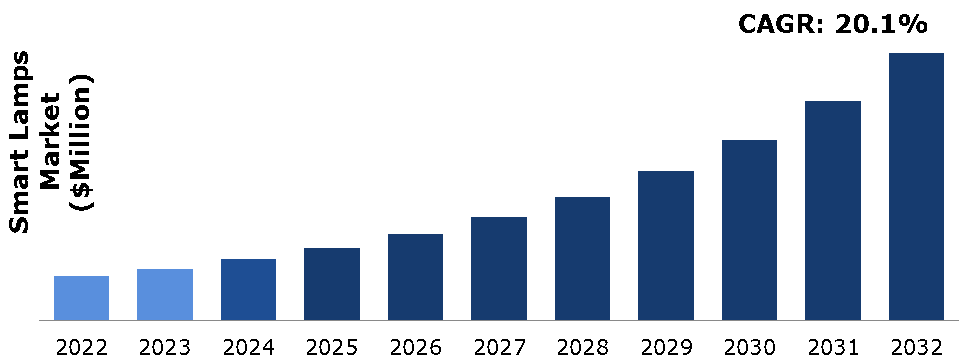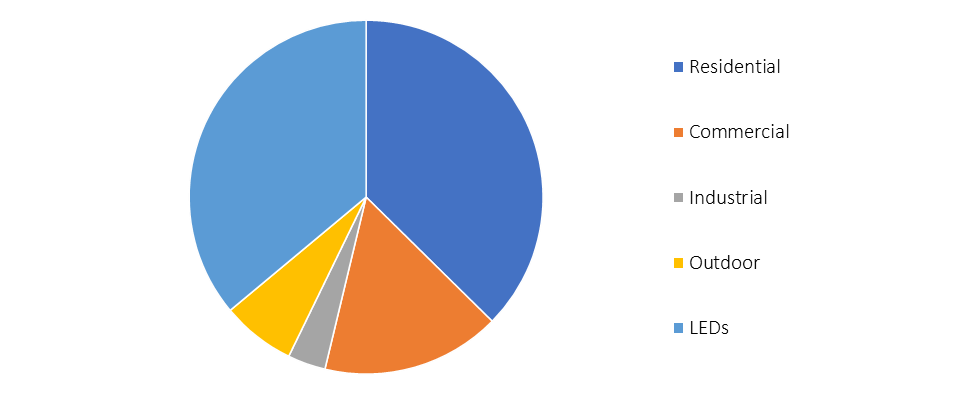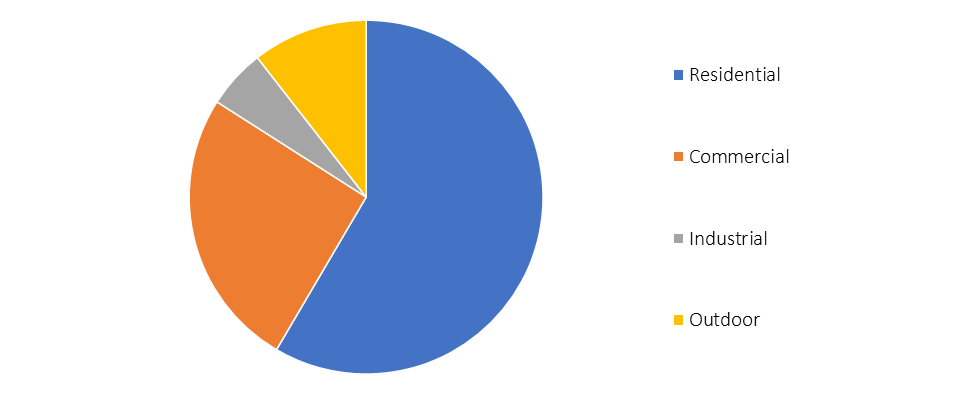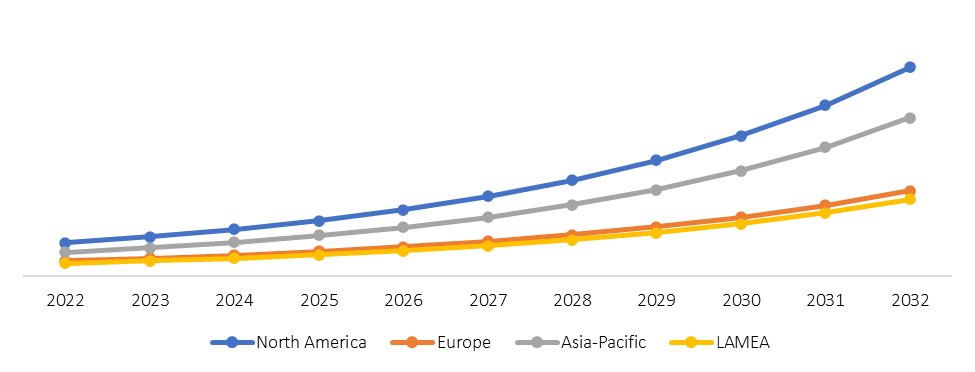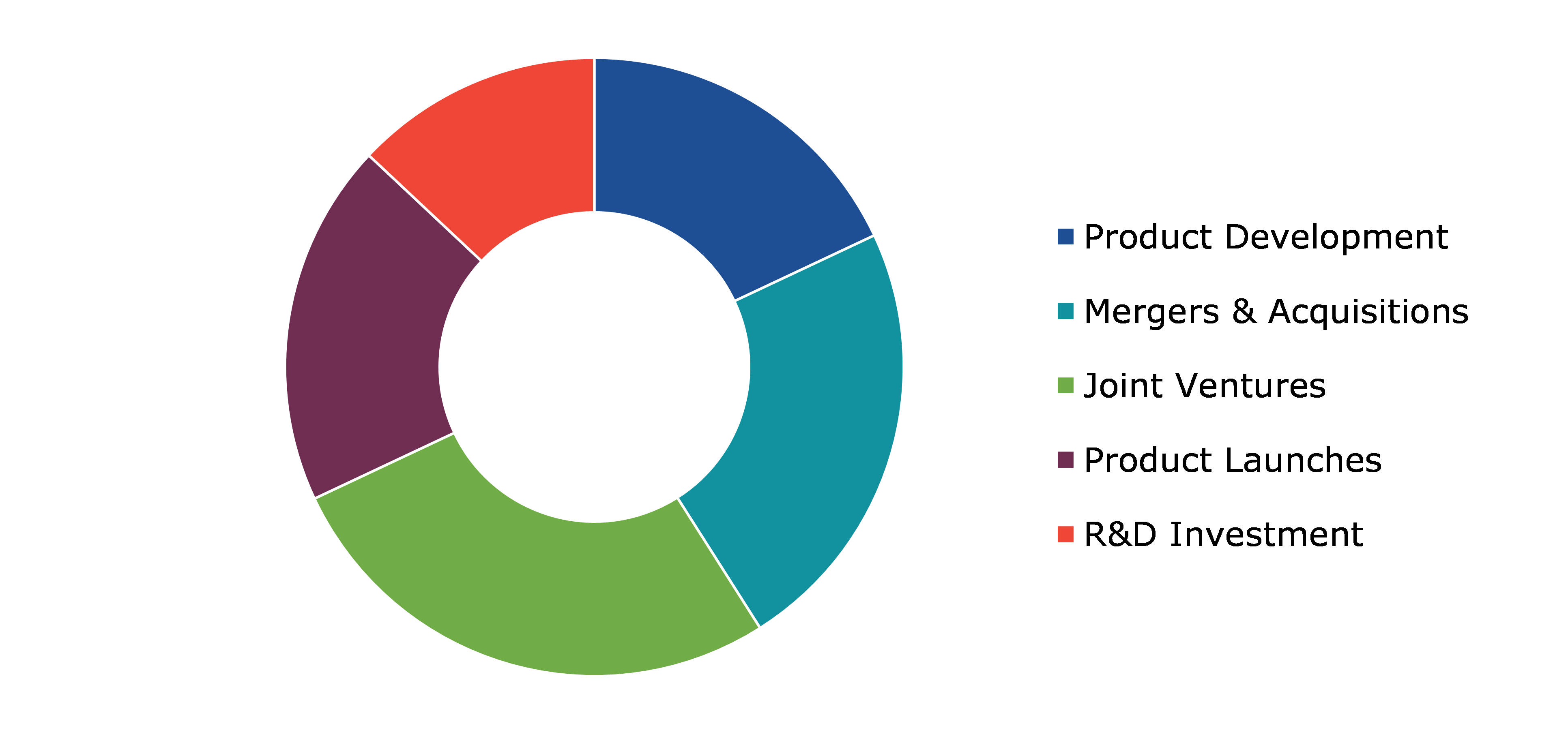Smart Lamps Market Report
RA09241
Smart Lamps Market by Type (Incandescents, Halogen, Compact Fluorescents, Linear Fluorescents, and LEDs), Application (Residential, Commercial, Industrial, and Outdoor), and Region (North America, Europe, Asia-Pacific, and LAMEA): Global Opportunity Analysis and Industry Forecast, 2023-2032
Smart Lamps Overview
Smart lamps also known as smart light bulbs or intelligent lighting, are lighting fixtures equipped with technology that allows them to connect to the Internet or a home automation system. Brightness, color, and other features of these lamps can be operated using remote control and automation. Smart lamps can be controlled using smartphones, tablets, or voice commands through virtual assistants like Amazon Alexa, Google Assistant, or Apple HomeKit. This means user can turn them on or off and adjust their settings from anywhere with the help of an Internet connection.
Many smart lamps offer the ability to adjust their brightness levels and change the color of the light they emit. This feature is popular for setting the mood in a room, whether user wants bright white light for productivity or soft warm light for relaxation. Smart lamps can be integrated into larger smart home environments. For example, they can work with motion sensors to automatically turn on when someone enters a room or sync with music for dynamic lighting effects during parties. Some smart lamps are designed to be energy-efficient, allowing user to reduce their electricity consumption by controlling usage more effectively.
Global Smart Lamps Market Analysis
The global smart lamps market size was $,4,105.60 million in 2022 and is predicted to grow with a CAGR of 20.1%, by generating a revenue of $25,131.50 million by 2032.
Source: Research Dive Analysis
COVID-19 Impact on Global Smart Lamps Market
The COVID-19 pandemic has had a significant impact on the smart lamps market. The pandemic disrupted global supply chains, affecting the production and distribution of electronics, including smart lamps. Many manufacturers faced challenges in sourcing components and raw materials, which led to delays in production and increased costs. With lockdowns and remote work becoming more prevalent during the pandemic, there was an increase in focus on home environments. This has driven higher demand for home improvement and smart home products, including smart lamps, as people spent more time at home. Due to concerns about in-person shopping and lockdown restrictions, e-commerce sector experienced significant growth during the pandemic. Many consumers turned to online platforms to purchase smart lamps and other home products, boosting the sales of these items through digital channels. The pandemic highlighted the importance of touchless technologies and automation. Smart lamps that can be controlled remotely via smartphones or voice assistants gained popularity as they offered convenience and hygiene benefits. Manufacturers focused on developing lamps with features that catered to the changing needs of consumers during the pandemic, such as UV-C disinfection capabilities or color temperature adjustment to support remote work.
Rising Demand for Home Automation to Drive the Market Growth
Smart lamps offer users the convenience of controlling lighting with ease. With voice-activated assistants like Amazon Alexa and Google Assistant, users can adjust the brightness and color of smart lamps using simple voice commands. Smartphone apps also provide remote control, allowing users to customize lighting settings from anywhere and enhancing overall convenience. Moreover, many smart lamps are equipped with energy-efficient LED bulbs and sensors that can detect occupancy and natural light levels. This leads to energy savings as the lamps can automatically adjust their brightness based on the available natural light or occupancy in the room and reducing electricity consumption. Furthermore, smart lamps allow users to personalize the lighting experience. They can choose from a wide range of colors and color temperatures to create the desired ambiance. Some lamps even have preset lighting scenes for different moods and activities, making customization easy and enjoyable. Moreover, smart lamps are designed to seamlessly integrate into existing smart home ecosystems. They can be synchronized with other smart devices such as thermostats or smart locks and security cameras. This integration enhances the overall home automation experience, allowing users to create automation routines and scenarios. In addition, motion sensors in some smart lamps can trigger lights to turn on when movement is detected, enhancing safety and visibility.
High Manufacturing Cost to Restrain the Market Growth
Smart lamps are equipped with various technologies like Wi-Fi, Bluetooth, voice recognition, and sensors, which drive up their manufacturing costs. These components are necessary for the lamp to connect to a network, respond to voice commands, and interact with other smart devices. Developing and maintaining the software and mobile apps required to control smart lamps also adds to the cost. Regular updates and compatibility improvements are needed to ensure a seamless user experience. Many smart lamps are designed to work within a broader smart home ecosystem, which often requires compatibility with various platforms and protocols. This integration can increase development costs and result in licensing fees. Some smart lamps are designed to be aesthetically pleasing and may incorporate premium materials, unique designs, or advanced features like color-changing capabilities. While the cost of smart lamps remains a restraint for some consumers, the convenience, energy efficiency, and customization options they offer can justify the initial investment for many individuals interested in upgrading their home lighting systems and embracing smart home technology. These are the major factors anticipated to hamper the smart lamps market growth.
Growing Adoption of Smart Home Technology to Drive Excellent Opportunities
Smart lamps are an integral part of the smart home ecosystem, offering convenience, energy efficiency, and enhanced functionality. Manufacturers can capitalize on this trend by offering compatible smart lamps and promoting seamless integration with popular smart home platforms like Amazon Alexa, Google Assistant, and Apple HomeKit. Smart lamps automatically adjust brightness based on ambient light conditions or user preferences which leads to energy savings over time. Smart lamps offer a wide range of customization options including the ability to change colors, set scenes, and create different ambiance settings. This appeals to users looking to personalize their lighting experience. This enhances both convenience and security for homeowners. From basic white LED smart bulbs to more advanced RGB color-changing lamps, having a diverse product lineup can attract a broader customer base. The continuous technological advancements offer a wide range of opportunities for key players operating in the smart lamps market.
Global Smart Lamps Market Share, by Type, 2022
Source: Research Dive Analysis
The LEDs sub-segment accounted for the highest market share in 2022. LEDs are highly energy-efficient compared to traditional incandescent or fluorescent bulbs. They consume significantly less power while providing the same or even better illumination. This energy efficiency appeals to consumers as it reduces electricity bills and lowers the carbon footprint. Moreover, LEDs have a much longer lifespan than traditional bulbs. They can last for tens of thousands of hours, reducing the frequency of bulb replacements. This longevity is a significant selling point for smart lamps as consumers appreciate the convenience and cost savings of not having to replace bulbs frequently. The combination of energy efficiency and longevity leads to cost savings for consumers over time. Furthermore, governments of various countries around the world have implemented regulations to phase out inefficient lighting technologies like incandescent bulbs and promote the use of energy-efficient LEDs. Incentives such as rebates and subsidies further encourage the adoption of LEDs. Advances in LED technology have led to better color rendering, increased brightness, and improved efficiency. These innovations make LEDs even more attractive to consumers. LEDs are often incorporated into sleek and modern lamp designs, making them aesthetically appealing to consumers who value both form and function in their home decor. Some smart lamps with LED lighting can be programmed to mimic natural daylight, which can have positive effects on circadian rhythms and overall well-being.
Global Smart Lamps Market Share, by Application, 2022
Source: Research Dive Analysis
The commercial sub-segment accounted for the highest market share in 2022. Commercial establishments are often looking for ways to reduce energy consumption and lower utility costs. Smart lamps, with features such as dimming and scheduling, can optimize lighting based on occupancy and natural light, thereby saving energy and reducing electricity bills. Smart lamps can have a higher upfront cost compared to traditional lighting, but they offer long-term cost savings due to their energy efficiency and longer lifespan. Commercial businesses appreciate the potential for reduced maintenance and replacement costs. Several businesses are committed toward sustainability and environmental responsibility. Smart lamps with energy-saving features help businesses reduce their carbon footprint, align with environmental regulations, and meet corporate sustainability goals. Smart lamps allow for precise control over lighting conditions. Businesses can adjust lighting levels, colors, and schedules remotely, creating comfortable and productive work environments. Automation features also contribute to ease of use and energy efficiency. Proper lighting can have a significant impact on employee productivity, comfort, and well-being. Commercial spaces can use smart lamps to create lighting environments that support task-specific needs, reduce eye strain, and enhance overall employee satisfaction. Smart lamps can be integrated with BMS and IoT platforms, enabling centralized control and monitoring of various building systems, including lighting. This integration simplifies facility management and allows for coordinated energy-saving strategies.
Global Smart Lamps Market Size & Forecast, by Region, 2022-2032 ($Million)
Source: Research Dive Analysis
The North America smart lamps market generated the highest revenue in 2022. The growing trend of turning homes into smart homes has led to increased consumer interest in smart lighting solutions, including smart lamps. Consumers in the region are looking for convenience, energy efficiency, and customization in their lighting, driving the demand for smart lamps. The growing trend of home automation and the desire for connected and smart homes have led to the increased adoption of smart lamps in North America. Consumers in the region are looking for lighting solutions that can be controlled remotely via smartphones or voice assistants, and smart lamps meet this need. Moreover, smart lamps often come with energy-efficient LED technology and features like dimming and scheduling, which help consumers save on energy costs. Many North American consumers are environmentally conscious and appreciate the energy-saving benefits of smart lighting. Smart lamps allow users to customize their lighting according to their preferences, such as color, brightness, and ambiance. The convenience of adjusting lighting to suit different moods and activities is appealing to consumers in North America.
Competitive Scenario in the Global Smart Lamps Market
Investment and agreement are common strategies followed by major market players. In February 2023, Signify helped the German municipality of Eichenzell become a future-proof smart city through intelligent street lighting. Its BrightSites solution brings fast, wireless broadband connectivity to the city, allowing Eichenzell to cater to next-generation IoT applications and future 5G densification. Signify installed LED lighting, which is managed by the Interact City System. Eichenzell can continuously monitor and manage all lights from a single dashboard.
Source: Research Dive Analysis
Some of the companies operating in the smart lamps market are Honeywell International Inc., Syska, Cree Inc., Acuity Brands Inc., Cisco Systems Inc., Deco Lighting Inc., Eaton, Dialight, Koninklijke Philips N.V., and General Electric.
| Aspect | Particulars |
| Historical Market Estimations | 2020-2021 |
| Base Year for Market Estimation | 2022 |
| Forecast Timeline for Market Projection | 2023-2032 |
| Geographical Scope | North America, Europe, Asia-Pacific, and LAMEA |
| Segmentation by Type |
|
| Segmentation by Application |
|
| Key Companies Profiled |
|
Q1. What is the size of the global smart lamps market?
A. The size of the global smart lamps market was over $ 4105.60 million in 2022 and is projected to reach $ 25131.50 million by 2032.
Q2. Which are the major companies in the smart lamps market?
A. Acuity Brands Inc. and Cisco Systems Inc. are some of the key players in the global smart lamps market.
Q3. Which region, among others, possesses greater investment opportunities in the future?
A. Asia-Pacific possesses great investment opportunities for investors in the future.
Q4. What will be the growth rate of the Asia-Pacific smart lamps market?
A. The Asia-Pacific smart lamps market is anticipated to grow at 20.1% CAGR during the forecast period.
Q5. What are the strategies opted by the leading players in this market?
A. Agreement and investment are the two key strategies opted by the operating companies in this market.
Q6. Which companies are investing more on R&D practices?
A. Honeywell International Inc., Syska., and Cree Inc. are the companies investing more on R&D activities for developing new products and technologies.
1. Research Methodology
1.1. Desk Research
1.2. Real time insights and validation
1.3. Forecast model
1.4. Assumptions and forecast parameters
1.5. Market size estimation
1.5.1. Top-down approach
1.5.2. Bottom-up approach
2. Report Scope
2.1. Market definition
2.2. Key objectives of the study
2.3. Report overview
2.4. Market segmentation
2.5. Overview of the impact of COVID-19 on global smart lamps market
3. Executive Summary
4. Market Overview
4.1. Introduction
4.2. Growth impact forces
4.2.1. Drivers
4.2.2. Restraints
4.2.3. Opportunities
4.3. Market value chain analysis
4.3.1. List of raw material suppliers
4.3.2. List of manufacturers
4.3.3. List of distributors
4.4. Innovation & sustainability matrices
4.4.1. Technology matrix
4.4.2. Regulatory matrix
4.5. Porter’s five forces analysis
4.5.1. Bargaining power of suppliers
4.5.2. Bargaining power of consumers
4.5.3. Threat of substitutes
4.5.4. Threat of new entrants
4.5.5. Competitive rivalry intensity
4.6. PESTLE analysis
4.6.1. Political
4.6.2. Economical
4.6.3. Social
4.6.4. Technological
4.6.5. Environmental
4.7. Impact of COVID-19 on Smart Lamps Market
4.7.1. Pre-covid market scenario
4.7.2. Post-covid market scenario
5. Smart Lamps Market Analysis, by Type
5.1. Overview
5.2. Incandescents
5.2.1. Definition, key trends, growth factors, and opportunities
5.2.2. Market size analysis, by region, 2022-2032
5.2.3. Market share analysis, by country, 2022-2032
5.3. Halogen
5.3.1. Definition, key trends, growth factors, and opportunities
5.3.2. Market size analysis, by region, 2022-2032
5.3.3. Market share analysis, by country, 2022-2032
5.4. Compact Fluorescents
5.4.1. Definition, key trends, growth factors, and opportunities
5.4.2. Market size analysis, by region, 2022-2032
5.4.3. Market share analysis, by country, 2022-2032
5.5. Linear Fluorescents
5.5.1. Definition, key trends, growth factors, and opportunities
5.5.2. Market size analysis, by region, 2022-2032
5.5.3. Market share analysis, by country, 2022-2032
5.6. LEDs
5.6.1. Definition, key trends, growth factors, and opportunities
5.6.2. Market size analysis, by region, 2022-2032
5.6.3. Market share analysis, by country, 2022-2032
5.7. Research Dive Exclusive Insights
5.7.1. Market attractiveness
5.7.2. Competition heatmap
6. Smart Lamps Market Analysis, by Application
6.1. Residential
6.1.1. Definition, key trends, growth factors, and opportunities
6.1.2. Market size analysis, by region, 2022-2032
6.1.3. Market share analysis, by country, 2022-2032
6.2. Commercial
6.2.1. Definition, key trends, growth factors, and opportunities
6.2.2. Market size analysis, by region, 2022-2032
6.2.3. Market share analysis, by country, 2022-2032
6.3. Industrial
6.3.1. Definition, key trends, growth factors, and opportunities
6.3.2. Market size analysis, by region, 2022-2032
6.3.3. Market share analysis, by country, 2022-2032
6.4. Outdoor
6.4.1. Definition, key trends, growth factors, and opportunities
6.4.2. Market size analysis, by region, 2022-2032
6.4.3. Market share analysis, by country, 2022-2032
6.5. Research Dive Exclusive Insights
6.5.1. Market attractiveness
6.5.2. Competition heatmap
7. Smart Lamps Market, by Region
7.1. North America
7.1.1. U.S.
7.1.1.1. Market size analysis, by Type, 2022-2032
7.1.1.2. Market size analysis, by Application, 2022-2032
7.1.2. Canada
7.1.2.1. Market size analysis, by Type, 2022-2032
7.1.2.2. Market size analysis, by Application, 2022-2032
7.1.3. Mexico
7.1.3.1. Market size analysis, by Type, 2022-2032
7.1.3.2. Market size analysis, by Application, 2022-2032
7.1.4. Research Dive Exclusive Insights
7.1.4.1. Market attractiveness
7.1.4.2. Competition heatmap
7.2. Europe
7.2.1. Germany
7.2.1.1. Market size analysis, by Type, 2022-2032
7.2.1.2. Market size analysis, by Application, 2022-2032
7.2.2. UK
7.2.2.1. Market size analysis, by Type, 2022-2032
7.2.2.2. Market size analysis, by Application, 2022-2032
7.2.3. France
7.2.3.1. Market size analysis, by Type, 2022-2032
7.2.3.2. Market size analysis, by Application, 2022-2032
7.2.4. Spain
7.2.4.1. Market size analysis, by Type, 2022-2032
7.2.4.2. Market size analysis, by Application, 2022-2032
7.2.5. Italy
7.2.5.1. Market size analysis, by Type, 2022-2032
7.2.5.2. Market size analysis, by Application, 2022-2032
7.2.6. Rest of Europe
7.2.6.1. Market size analysis, by Type, 2022-2032
7.2.6.2. Market size analysis, by Application, 2022-2032
7.2.7. Research Dive Exclusive Insights
7.2.7.1. Market attractiveness
7.2.7.2. Competition heatmap
7.3. Asia-Pacific
7.3.1. China
7.3.1.1. Market size analysis, by Type, 2022-2032
7.3.1.2. Market size analysis, by Application, 2022-2032
7.3.2. Japan
7.3.2.1. Market size analysis, by Type, 2022-2032
7.3.2.2. Market size analysis, by Application, 2022-2032
7.3.3. India
7.3.3.1. Market size analysis, by Type, 2022-2032
7.3.3.2. Market size analysis, by Application, 2022-2032
7.3.4. Australia
7.3.4.1. Market size analysis, by Type, 2022-2032
7.3.4.2. Market size analysis, by Application, 2022-2032
7.3.5. South Korea
7.3.5.1. Market size analysis, by Type, 2022-2032
7.3.5.2. Market size analysis, by Application, 2022-2032
7.3.6. Rest of Asia-Pacific
7.3.6.1. Market size analysis, by Type, 2022-2032
7.3.6.2. Market size analysis, by Application, 2022-2032
7.3.7. Research Dive Exclusive Insights
7.3.7.1. Market attractiveness
7.3.7.2. Competition heatmap
7.4. LAMEA
7.4.1. Brazil
7.4.1.1. Market size analysis, by Type, 2022-2032
7.4.1.2. Market size analysis, by Application, 2022-2032
7.4.2. Saudi Arabia
7.4.2.1. Market size analysis, by Type, 2022-2032
7.4.2.2. Market size analysis, by Application, 2022-2032
7.4.3. UAE
7.4.3.1. Market size analysis, by Type, 2022-2032
7.4.3.2. Market size analysis, by Application, 2022-2032
7.4.4. South Africa
7.4.4.1. Market size analysis, by Type, 2022-2032
7.4.4.2. Market size analysis, by Application, 2022-2032
7.4.5. Rest of LAMEA
7.4.5.1. Market size analysis, by Type, 2022-2032
7.4.5.2. Market size analysis, by Application, 2022-2032
7.4.6. Research Dive Exclusive Insights
7.4.6.1. Market attractiveness
7.4.6.2. Competition heatmap
8. Competitive Landscape
8.1. Top winning strategies, 2022
8.1.1. By strategy
8.1.2. By year
8.2. Strategic overview
8.3. Market share analysis, 2022
9. Company Profiles
9.1. Honeywell International Inc.
9.1.1. Overview
9.1.2. Business segments
9.1.3. Product portfolio
9.1.4. Financial performance
9.1.5. Recent developments
9.1.6. SWOT analysis
9.2. Syska
9.2.1. Overview
9.2.2. Business segments
9.2.3. Product portfolio
9.2.4. Financial performance
9.2.5. Recent developments
9.2.6. SWOT analysis
9.3. Cree Inc.
9.3.1. Overview
9.3.2. Business segments
9.3.3. Product portfolio
9.3.4. Financial performance
9.3.5. Recent developments
9.3.6. SWOT analysis
9.4. Acuity Brands Inc.
9.4.1. Overview
9.4.2. Business segments
9.4.3. Product portfolio
9.4.4. Financial performance
9.4.5. Recent developments
9.4.6. SWOT analysis
9.5. Cisco Systems Inc.
9.5.1. Overview
9.5.2. Business segments
9.5.3. Product portfolio
9.5.4. Financial performance
9.5.5. Recent developments
9.5.6. SWOT analysis
9.6. Deco Lighting Inc.
9.6.1. Overview
9.6.2. Business segments
9.6.3. Product portfolio
9.6.4. Financial performance
9.6.5. Recent developments
9.6.6. SWOT analysis
9.7. Eaton
9.7.1. Overview
9.7.2. Business segments
9.7.3. Product portfolio
9.7.4. Financial performance
9.7.5. Recent developments
9.7.6. SWOT analysis
9.8. Dialight
9.8.1. Overview
9.8.2. Business segments
9.8.3. Product portfolio
9.8.4. Financial performance
9.8.5. Recent developments
9.8.6. SWOT analysis
9.9. Koninklijke Philips N.V.
9.9.1. Overview
9.9.2. Business segments
9.9.3. Product portfolio
9.9.4. Financial performance
9.9.5. Recent developments
9.9.6. SWOT analysis
9.10. General Electric
9.10.1. Overview
9.10.2. Business segments
9.10.3. Product portfolio
9.10.4. Financial performance
9.10.5. Recent developments
9.10.6. SWOT analysis
Personalize this research
- Triangulate with your own data
- Request your format and definition
- Get a deeper dive on a specific application, geography, customer or competitor
- + 1-888-961-4454 Toll - Free
- support@researchdive.com

